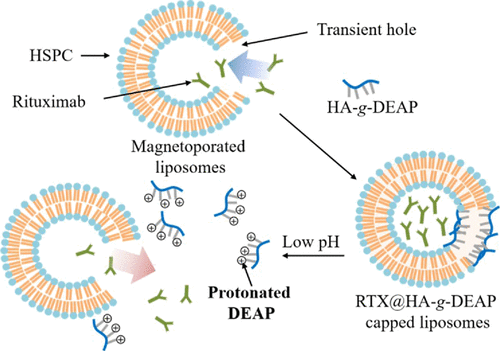当前位置:
X-MOL 学术
›
Biomacromolecules
›
论文详情
Our official English website, www.x-mol.net, welcomes your
feedback! (Note: you will need to create a separate account there.)
Tumor-Targeting Liposomes with Transient Holes Allowing Intact Rituximab Internally
Biomacromolecules ( IF 5.5 ) Pub Date : 2020-12-06 , DOI: 10.1021/acs.biomac.0c01514 Yoonyoung Kim 1 , Yu Seok Youn 2 , Kyung Taek Oh 3 , Dongin Kim 4 , Eun Seong Lee 1, 5
Biomacromolecules ( IF 5.5 ) Pub Date : 2020-12-06 , DOI: 10.1021/acs.biomac.0c01514 Yoonyoung Kim 1 , Yu Seok Youn 2 , Kyung Taek Oh 3 , Dongin Kim 4 , Eun Seong Lee 1, 5
Affiliation

|
In this study, the strategy of transient generation of holes in the liposome surface has been shown to enable safe encapsulation of a high-molecular weight antibody (rituximab, Mw ∼140 kDa) within liposomes. These transient holes generated using our magnetoporation method allowed rituximab to safely enter the liposomes, and then the holes were plugged using hyaluronic acid grafted with 3-diethylaminopropylamine (DEAP). In the tumor microenvironment, the resulting liposomal rituximab was destabilized because of the ionization of the DEAP moiety at the acidic pH 6.5, resulting in extensive release of rituximab. Consequently, the rituximab released from the liposomes accumulated at high levels in tumors and bound to the CD20 receptors overexpressed on Burkitt lymphoma Ramos cells. This event led to significant enhancement in tumor cell ablation through rituximab-mediated complement-dependent cytotoxicity and Bcl-2 signaling inhibition-induced cell apoptosis.
中文翻译:

具有瞬时孔的肿瘤靶向脂质体,允许内部完整的利妥昔单抗
在这项研究中,瞬时产生在脂质体表面的孔的策略已被示出,以使高分子量抗体的安全封装(利妥昔单抗,中号瓦特脂质体内~140 kDa)的。使用我们的磁化方法产生的这些瞬态孔使利妥昔单抗安全进入脂质体,然后使用嫁接有3-二乙基氨基丙胺(DEAP)的透明质酸堵塞孔。在肿瘤微环境中,由于DEAP部分在酸性pH 6.5处电离,导致所得的利妥昔单抗脂质体不稳定,导致利妥昔单抗大量释放。因此,从脂质体释放的利妥昔单抗在肿瘤中高水平积累,并与在伯基特淋巴瘤上过表达的CD20受体结合拉莫斯细胞。该事件通过利妥昔单抗介导的补体依赖性细胞毒性和Bcl-2信号抑制诱导的细胞凋亡导致肿瘤细胞消融显着增强。
更新日期:2021-02-08
中文翻译:

具有瞬时孔的肿瘤靶向脂质体,允许内部完整的利妥昔单抗
在这项研究中,瞬时产生在脂质体表面的孔的策略已被示出,以使高分子量抗体的安全封装(利妥昔单抗,中号瓦特脂质体内~140 kDa)的。使用我们的磁化方法产生的这些瞬态孔使利妥昔单抗安全进入脂质体,然后使用嫁接有3-二乙基氨基丙胺(DEAP)的透明质酸堵塞孔。在肿瘤微环境中,由于DEAP部分在酸性pH 6.5处电离,导致所得的利妥昔单抗脂质体不稳定,导致利妥昔单抗大量释放。因此,从脂质体释放的利妥昔单抗在肿瘤中高水平积累,并与在伯基特淋巴瘤上过表达的CD20受体结合拉莫斯细胞。该事件通过利妥昔单抗介导的补体依赖性细胞毒性和Bcl-2信号抑制诱导的细胞凋亡导致肿瘤细胞消融显着增强。











































 京公网安备 11010802027423号
京公网安备 11010802027423号